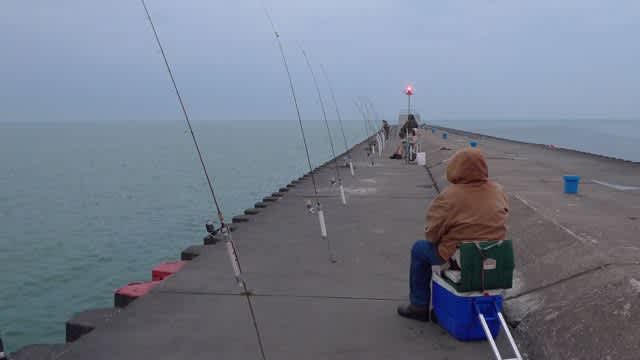Pier Fishing for Peerless Michigan Whitefish
Dave Mull 11.09.12

Despite how good they taste and (often) how easy they are to catch with basic gear, Great Lakes whitefish don’t get a lot of attention from Michigan anglers.
And right now, almost any Lake Michigan pier offers a chance to grapple with these small-mouthed relatives of trout and salmon.

Martin Moore of Hartford invited myself and our mutual friend Bud Roche for a morning of whitefish fishing off of the pier at St. Joseph in the southwest part of the state. Moore is a longtime pier angler and has his whitefish program dialed in. He insisted on supplying the rods, holders and bait—salmon eggs he pre-cooks, adding garlic and other scents to different batches.
“I put them in a pan of cold water, turn on the heat and bring it to a boil, testing the consistency of the individual eggs with a needle,” he explained. “Start testing after about two minutes. I want them to have the consistency of peanut butter. When they’re ready, I drain ‘em and put them in cold water to stop cooking.”
This day he brought a natural, no-scent-added batch, a couple of different garlic-scented bottles and some with his “secret” scent, which is the juice squeezed from steelhead skein.
We started fishing well before daylight, rigging rods and baiting up with the help of headlamps. Like most whitefish anglers, Moore likes long rods with limber tips that show bites, but with enough backbone to toss a two-ounce pyramid sinker. The heavy weight is needed to keep lines pinned to the bottom so they don’t get carried into other lines by ever-present current. The sinker is rigged to slide on the main line so a fish can swim a bit with the bait.

His main line is a non-stretch 20-pound braid that is strong for its diameter and shows bites immediately. A four-foot leader of 12-pound test P-Line-brand fluorocarbon goes between the swivel that keeps the sinker on the braided line and the size 6 octopus-style hook. Moore threads three eggs on the hook and carefully tosses the rig 30 to 60 feet straight out from the pier—straight out helps avoid tangles with other lines.
Rods get set in rod holders, home made of 16-inch long PVC pipe attached with duct tape to three-foot sections of rebar or other bar stock that can be pounded in to holes in the concrete pier. Some piers don’t have such holes, and anglers must attach rod holders to the carts and seats they bring out with them.
As we were out before daylight, Moore slid a tiny glow stick into bells on a clip designed to attach near the end of the fishing rod. The glow stick showed bites in the dark and the bells alerted us when a fish was biting.

While the fishing had been hot for the past several days, the curse of an outdoor writer with a camera went into effect—we only caught one small one, and action wasn’t a whole lot better for the other anglers on the pier. Al Lutz, one of Moore’s pier friends, was set up on the shore side of our nine rods and wrangled a nice fish of about three pounds. A pair of anglers farther out caught a couple, but overall, the consensus was the bite had cooled off from earlier in the week.
Right now is just the beginning of prime time to catch these fish, as they foray into shallower water after living all summer in the dark depths of the big lake—200 feet and deeper. As the water temps fall, the whitefish follow spawning lake trout onto the shallows and prepare to spawn themselves in depths of less than 25 feet. While pier-bound anglers may watch rods for hours between bites, schools of fish can move in and heat up the action in a hurry.
Natural food for whitefish includes insects and insect larvae, freshwater shrimp and small fish in addition to fish eggs. That means anglers without easy access to salmon eggs can still catch fish with wigglers, maggots, waxworms and other live bait. In places where casting won’t interfere with other anglers, small jigging spoons and blade baits such as Cicadas can get hits from fish. Moore points out that most of the time, whitefish swallow the hook, and are difficult to release alive; anglers generally keep their catch. And few anglers complain about that, since the delicate white flesh of whitefish is among the best of any freshwater fish species.
For more information on Michigan fishing go to michigan.org.

